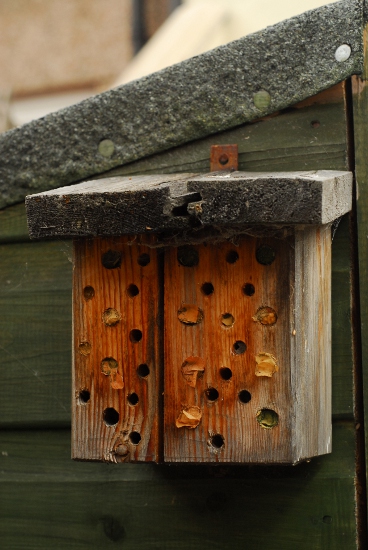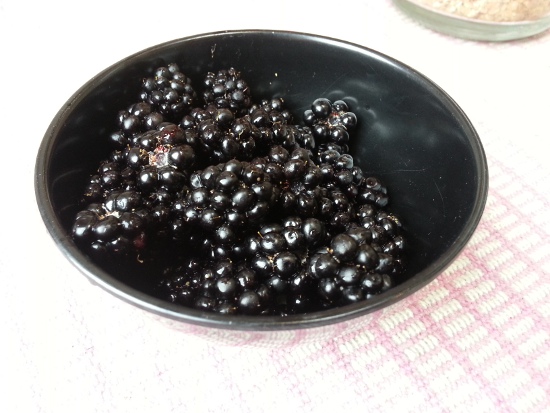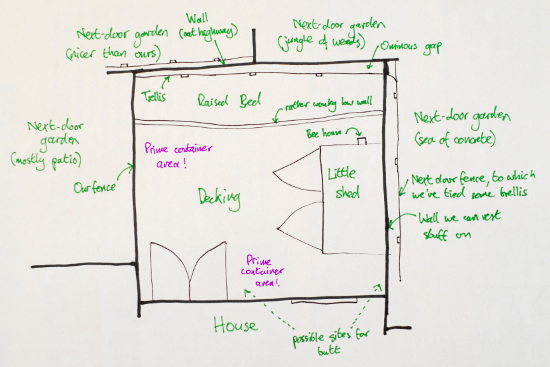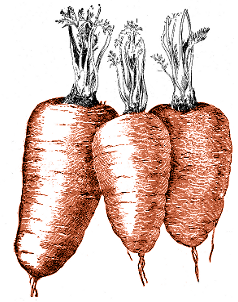Posted in Environmentalism, Garden Diary, The Old Garden In Bristol on Saturday, September 14th 2013 (10.32 PM).
There is one benefit, of course, to leaving the garden to go to seed for a year. It means that the wildlife can get along with things all on their own, without me coming along to pull up their homes and generally keep disturbing things. Whilst clearing the garden up in the past few weeks, we’ve seen lots of shieldbugs, crab spiders, caterpillars, various different insects and suchlike going about their own business and making the most of the place.
A couple of years ago, we bought a bee house, and nailed it up on the wall of the shed. It saw little use, to be honest, apart from by spiders and a couple of holes filled by a mason bee last year. This summer, though, leafcutter bees have found it, and made good use of it.

As you can see from the picture, leafcutter bees are quite picky about the sizes of the holes they will lay eggs in. You can also see one of the holes which a mason bee presumably crawled out of earlier in the year. Hopefully, at some point in the spring, a family of newly-mature leafcutter bees will emerge again.
In other news, we have sowed a few flowers ready for next summer: calendula, forget-me-not and borage. Slowly we’re drifting away from the original idea of making the garden as edible as we could, but that was never a strictly hard-and-fast rule to start with. They are, at least, all flowers which should please the leafcutters and bumblebees at various times next spring and summer. On the herb front, we’ve acquired a few stems of bay, and planted them in one of the wastebins used in previous seasons for growing potatoes. Growing potatoes is difficult to justify in a garden the size of ours; hopefully the bay will make a bush to last for a few years to come.
bay, bee, bee house, borage, calendula, forget-me-not, leafcutter
Posted in Garden Diary, Planning, Retrospective, The Old Garden In Bristol on Saturday, September 7th 2013 (10.29 PM).
Regular readers of this site – all one of you – might have noticed that things have been rather quiet for a while here. There is, of course, a good reason for that. The reason is: the state of the garden, in the second half of last year, was such a disaster that I really didn’t feel like writing about it. I really didn’t feel like going into the garden. And so, nothing was put away for the winter, everything was left to fend for itself. A surprising amount of plants survived the winter, but the ones that did were mostly killed off by the heat earlier this summer. So now, effectively, we are starting again. The only produce we’ve had from the garden in 2013 is a small bowl from an interloper, something very tasty that we didn’t really ask for.

For some reason, gardening tasks always seem to end up involving brambles. I can dimly remember, aged about 5, my grandfather giving my parents a bramble shoot with the advice to keep it in a bucket lest it take over the whole garden. Naturally, by the time I had reached my teens, it had taken over, well, half the garden (the rest was lawn), and I spent what seems in memory to be most of a summer cutting it down, piece by piece, first with secateurs then with hacksaw, until my parents’ only option was to hire a wood chipper to deal with the pile of chunks. At the previous place we lived in Bristol, there was virtually no garden, and the only gardening task I ever did was regularly chop back a bramble which had managed to root itself under the decking. They really are amazing plants, in their ability to cover an area, take it over, turn everything underneath into a barren desert, and like bindweed they are endemic in this part of Bristol. So when I saw bramble runners sprouting forth over our back fence and dropping down seeking earth, I knew it had to go. After we’d eaten its fruit, of course.
The origin of the bramble is quickly explained, if we skip back to the garden plan posted a couple of years back:

That area at top-right marked “Jungle of weeds” was all dug up about a year ago. They now have a shed, backing on to our boundary, and a high wooden fence extending off to the right. However, the cleared land on their side of said fence has been left to revert back to weediness. With their new fence, there is now double the Ominous Gap marked on the plan, and it’s this gap which has been colonised by bramble. I can reach down and chop off anything threatening to poke its way over into our space, but I have no hope at all of digging up the roots. In other words, my life is once again doomed to regularly cutting back brambles.
Apart from the bramble-hacking, what are we going to do now that we’ve admitted we’re going to restart from scratch? Try to plant things that don’t take as much nursing, for one thing, so that the garden will survive if we want a summer holiday; and things that don’t necessarily look appetising to every slug and snail in town. Lots of herbs, lots of insect-attracting flowers, and maybe the odd item of produce that we can’t easily buy here. For now, we’ve cut down the weeds that were colonising the back bed and sowed white clover for the winter, to refresh its nitrates and try to give the weeds no space to come back. Before the winter, we’ll start growing a bulb’s worth of garlic, and sow our spring flowers: of all last year’s produce, the garlic was the best harvest, and was barely touched by pests. Then, next year, hopefully things will be green again.
blackberry, bramble, clover, garlic, weeds, white clover




